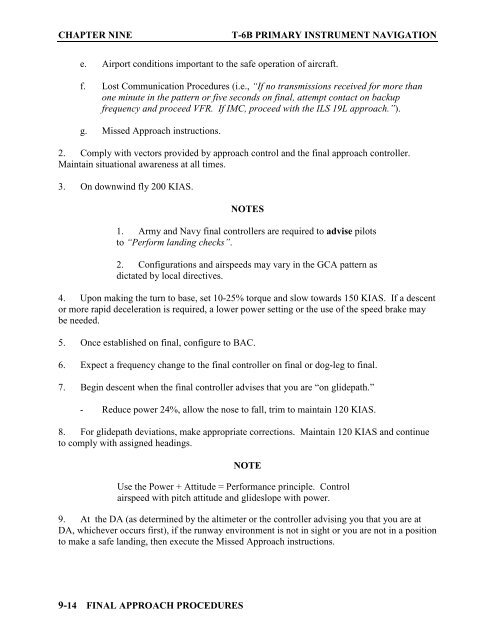Flight Training Instruction - Cnatra - U.S. Navy
Flight Training Instruction - Cnatra - U.S. Navy
Flight Training Instruction - Cnatra - U.S. Navy
You also want an ePaper? Increase the reach of your titles
YUMPU automatically turns print PDFs into web optimized ePapers that Google loves.
CHAPTER NINE T-6B PRIMARY INSTRUMENT NAVIGATION<br />
e. Airport conditions important to the safe operation of aircraft.<br />
f. Lost Communication Procedures (i.e., “If no transmissions received for more than<br />
one minute in the pattern or five seconds on final, attempt contact on backup<br />
frequency and proceed VFR. If IMC, proceed with the ILS 19L approach.”).<br />
g. Missed Approach instructions.<br />
2. Comply with vectors provided by approach control and the final approach controller.<br />
Maintain situational awareness at all times.<br />
3. On downwind fly 200 KIAS.<br />
9-14 FINAL APPROACH PROCEDURES<br />
NOTES<br />
1. Army and <strong>Navy</strong> final controllers are required to advise pilots<br />
to “Perform landing checks”.<br />
2. Configurations and airspeeds may vary in the GCA pattern as<br />
dictated by local directives.<br />
4. Upon making the turn to base, set 10-25% torque and slow towards 150 KIAS. If a descent<br />
or more rapid deceleration is required, a lower power setting or the use of the speed brake may<br />
be needed.<br />
5. Once established on final, configure to BAC.<br />
6. Expect a frequency change to the final controller on final or dog-leg to final.<br />
7. Begin descent when the final controller advises that you are “on glidepath.”<br />
- Reduce power 24%, allow the nose to fall, trim to maintain 120 KIAS.<br />
8. For glidepath deviations, make appropriate corrections. Maintain 120 KIAS and continue<br />
to comply with assigned headings.<br />
NOTE<br />
Use the Power + Attitude = Performance principle. Control<br />
airspeed with pitch attitude and glideslope with power.<br />
9. At the DA (as determined by the altimeter or the controller advising you that you are at<br />
DA, whichever occurs first), if the runway environment is not in sight or you are not in a position<br />
to make a safe landing, then execute the Missed Approach instructions.
















